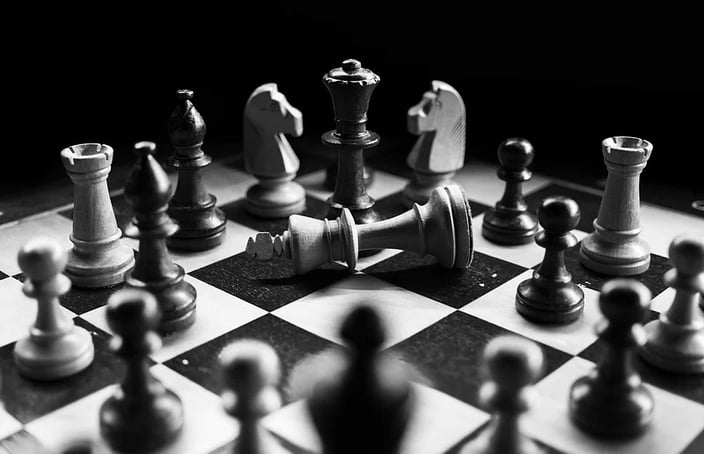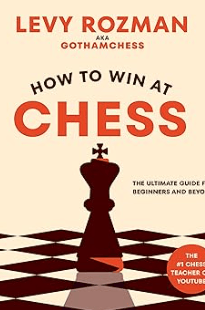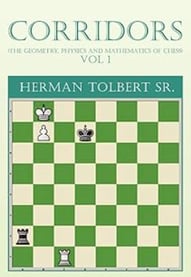The Hidden Geometry of Chess: How Mathematical Principles Shape the Royal Game
Discover how geometric principles influence chess strategy, from basic piece movements to advanced tactical patterns. Learn to improve your game through understanding chess geometry
CHESSMATH
Lukas Nyemcsik
1/19/20257 min read


The Hidden Geometry of Chess: How Mathematical Principles Shape the Royal Game
Chess, often called the game of kings, is as much a mathematical endeavor as it is a strategic battle. While casual players might see the game as a series of moves and countermoves, a deeper examination reveals that geometric principles underpin many of its fundamental concepts. From the basic movement patterns of pieces to complex positional strategies, geometry shapes every aspect of chess mastery. This guide will assist you in understanding these geometrical patterns in chess but "How to Win At Chess" by Levy Rozman provides a far more comprehensive guide to these core chess principles.
The Chessboard as a Coordinate Plane
At its most basic level, the chessboard itself is a geometric construct: an 8x8 grid that functions much like a coordinate plane in mathematics. This grid system, denoted by letters (a-h) for files and numbers (1-8) for ranks, creates a precise way to describe positions and movements. Just as mathematicians use coordinate geometry to analyze shapes and patterns, chess players use this grid to calculate moves and visualize tactical possibilities.
The intersection of files and ranks creates 64 squares, each serving as a potential position in the grand geometric dance of chess pieces. This geometric foundation becomes particularly important when we consider concepts like square control, piece mobility, and the creation of tactical patterns.
Piece Movement Patterns: Lines, Rays, and Vectors
Each chess piece moves according to specific geometric patterns that create unique tactical and strategic possibilities.
The Rook: Lines and Perpendicularity
The rook's movement embodies one of geometry's most fundamental concepts: straight lines. Moving horizontally and vertically, rooks trace paths that are perfectly perpendicular to each other. This geometric property makes rooks particularly powerful in controlling open files and ranks, creating what players call "linear control."
A rook's influence radiates outward in four directions, forming what geometers would recognize as rays extending from a central point. This property makes rooks especially effective in the endgame, where they can cut off enemy kings using these linear barriers.
Consider this common endgame scenario: A rook on the seventh rank (R-e7) restricts the enemy king's movement along an entire horizontal line while simultaneously threatening vertical attacks. This geometric principle is so powerful that grandmasters often say "a rook on the seventh is worth a pawn."
The Bishop: Diagonals and Parallel Lines
Bishops move exclusively along diagonals, maintaining a constant 45-degree angle relative to the board's edges. This geometric constraint means that a bishop starting on a light square will always remain on light squares, while a dark-square bishop can never leave its dark-square domain. This geometric limitation creates interesting strategic considerations in positions where controlling squares of a particular color becomes crucial.
The parallel nature of diagonal movement also means that two bishops working in tandem can create powerful geometric patterns, controlling large swaths of the board through intersecting diagonal lines. This geometric advantage is why the "bishop pair" is considered such a powerful asset, particularly in open positions.
The Queen: Combining Linear and Diagonal Forces
The queen's movement combines the geometric properties of both rooks and bishops, making it the most versatile piece. From a geometric perspective, the queen can move in eight different directions, creating a star-like pattern of influence. This geometric versatility explains why the queen is often the centerpiece of attacking combinations, able to exploit multiple geometric angles simultaneously.
The Knight: L-Shaped Mathematics
Perhaps the most geometrically interesting piece is the knight, moving in an L-shape that consists of two squares in one direction followed by one square perpendicular to the first movement. This unique geometric pattern means knights can reach squares that other pieces cannot easily defend, making them particularly effective at exploiting weaknesses in the opponent's position.
The knight's movement pattern also creates interesting geometric possibilities for tactical motifs like forks, where a single knight threatens two or more pieces simultaneously by virtue of its L-shaped reach.
Tactical Patterns and Geometric Motifs
Many common tactical patterns in chess are fundamentally geometric in nature and understanding these patterns can dramatically improve your play.
The Pin
A pin is a geometric alignment where one piece is prevented from moving because doing so would expose a more valuable piece to capture. This tactical motif relies on the concept of collinearity – three or more points lying on the same straight line. The pinning piece, the pinned piece, and the valuable piece behind it must all lie along the same geometric ray for a pin to be effective.
Example Position:
White Bishop on c4
Black Knight on e6
Black King on g8
In this common position, the knight is "absolutely pinned" to the king, as moving it would expose the king to check along the c4-g8 diagonal.
The Skewer
Similar to the pin but reversed in order, the skewer also relies on geometric alignment. Here, a more valuable piece is forced to move, exposing a less valuable piece behind it to capture. The geometric principle remains the same – three pieces must align along a single line or diagonal.
The Fork
Forks exploit geometric relationships by placing an attacking piece in a position where it simultaneously threatens two or more enemy pieces. The geometry of the fork often creates a triangle, with the attacking piece at one vertex and the threatened pieces at the others.
Classic Knight Fork Example:
White Knight on e7
Black King on g8
Black Rook on e8
This geometric arrangement allows the knight to simultaneously attack the king and rook, forcing a material advantage.
Advanced Geometric Patterns in Modern Chess
If you are seeking to better understand the detailed theoretical advanced geometry
of chess, as well as the math and physics of chess,
you will enjoy Herman Tolbert Sr's "Corridors: The Geometry, Physics and Math of Chess, Vol 1."
The Sicilian Dragon: Diagonal Power
The Sicilian Dragon variation demonstrates how geometric patterns influence opening strategy. The characteristic fianchettoed bishop on g7 controls the long dark-square diagonal, creating a powerful geometric weapon. This diagonal pressure often combines with rook placement on the c-file to create geometric patterns that target White's queenside.
The Maróczy Bind: Geometric Space Control
This pawn structure, typically featuring White pawns on c4 and e4, creates a geometric "bind" that restricts Black's piece movement. The pawns control key central squares while creating a geometric barrier that limits Black's counterplay. Understanding this geometric relationship helps players know where to place their pieces for maximum effectiveness.
Positional Play and Geometric Control
Beyond tactical considerations, geometric principles play a crucial role in positional strategy and long-term planning.
Pawn Structures
Pawn formations create geometric shapes that define the character of a position. Common structures like the isolated queen pawn, doubled pawns, or pawn chains all have specific geometric properties that influence both attacking and defensive possibilities.
Examples of Key Pawn Structures:
The French Defense Pawn Chain
Creates a diagonal chain from c7 to e5
Geometric properties determine piece placement and break points
Isolated Queen Pawn (IQP)
Central pawn on d4 with no supporting pawns on adjacent files
Creates unique geometric attacking patterns along semi-open files
Space and Territory
Control of space in chess can be understood through geometric concepts like area and perimeter. Players often speak of controlling the center, but this control is really about establishing geometric dominion over key squares and the lines that connect them.
Modern grandmasters like Magnus Carlsen excel at using geometric principles to gradually restrict their opponents' piece mobility, creating what's often called "positional suffocation."
The King's Geometry of Safety
King safety often depends on geometric considerations. A well-fortified king position typically involves creating geometric barriers using pawns and pieces. The concept of the "king's field" – the squares immediately surrounding the king – is inherently geometric, and understanding how to protect these squares often determines the outcome of an attack.
Practical Applications: Famous Games Showcasing Geometric Principles
Kasparov vs. Topalov (1999)
In this famous game, Kasparov's queen sacrifice demonstrated the power of geometric coordination between his remaining pieces. The rooks and bishop created a geometric net around Black's king, leading to a spectacular checkmate.
Key Position Analysis:
Rooks aligned on the seventh rank
Bishop controlling crucial diagonal
Geometric constriction of Black's king movement
Fischer vs. Spassky (1972)
Game 6 of their World Championship match showcased Fischer's understanding of geometric advantages with the bishop pair. The bishops' control of intersecting diagonals created insurmountable pressure on Spassky's position.
Endgame Geometry: The Final Phase
The endgame phase of chess perhaps best demonstrates the importance of geometric understanding. Here are some crucial geometric principles that every player should know:
Opposition
The concept of opposition in king and pawn endgames is purely geometric. Kings placed directly opposite each other with one square between form a critical geometric relationship that often determines who will win the game.
Triangulation
This geometric maneuver involves moving a king in a triangular pattern to lose a move while returning to the same position, often forcing the opponent into zugzwang. Understanding this geometric principle is essential for winning many theoretically drawn positions.
Rectangle Rule
In queen versus pawn endgames, the "rectangle rule" uses geometric principles to determine whether a pawn can be stopped from queening. Drawing a rectangle between the pawn and its queening square helps players quickly evaluate these positions.
Conclusion: The Geometric Mind in Chess
The relationship between geometry and chess is profound and multifaceted. From the basic movement patterns of pieces to complex positional concepts, geometric principles underlie virtually every aspect of the game. Understanding these geometric relationships can help players at all levels improve their tactical awareness and strategic planning.
Whether calculating tactical combinations, evaluating pawn structures, or planning endgame maneuvers, successful chess players must think geometrically. This geometric foundation not only helps explain why certain moves and positions work better than others but also provides a framework for understanding and improving one's chess abilities.
As players advance in their chess journey, developing a stronger geometric intuition can help them spot tactical opportunities more quickly and evaluate positions more accurately. The next time you sit down at a chess board, consider the geometric patterns at play – you might find yourself seeing the game in an entirely new light.
Key Takeaways for Improvement
Practice identifying geometric patterns in your games
Study classic games with attention to geometric themes
Use geometric principles to guide piece placement
Analyze your losses looking for missed geometric opportunities
Incorporate geometric thinking into your calculation process
Remember, every great chess player is, in some way, a geometer at heart. By developing your understanding of chess geometry, you're following in the footsteps of the masters who have used these principles to achieve greatness in the royal game.




